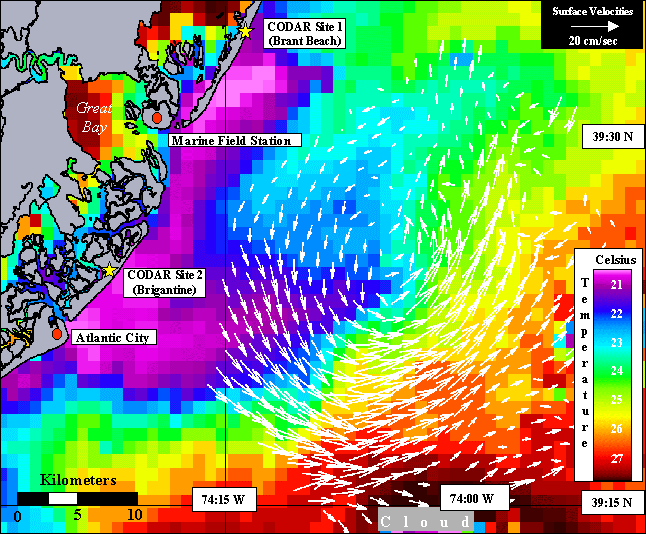
So how does it all work?
All the following theory is based on the CODAR (COastal raDAR) system.
The data acquisition of the system can be broken down in to three main components:
- Current Velocity of Target (Radial Component)
- Range to Target
- Angle of Target
I. Current Velocity of Target
The basic mechanics of a Hf_radar system is the analysis of a backscattered radio wave. The CODAR sytem works very much like a radio station in that it emits a radio signal. While a radio station does not monitor the signal that is scattered back to the station, a CODAR site uses this backscattered radio wave to calculate surface currents.
If the ocean were completely flat, no signals would be backscattered. Since the ocean is not flat, it scatters the radio signal in many different directions. In order to to amplify the protion of the scattered signal that is directed back to the reciever antenea, the CODAR system utilizes the principles of “Bragg Scattering”.
Resonant Bragg Scattering
Since the ocean surface scatters a signal in many different directions, some menchanism must be used to maximize the signal directed back to a CODAR reciever. Resonant Bragg Scattering basically amplifies the scattered signal directed toward the reciever using resonant theory. Resonance will only occur for certain signal wavelengths:
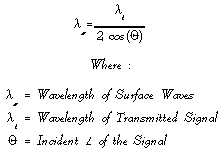
Since the CODAR antennas are very close to sea level, the incident angle of the signal is assumed to be zero. This assumption reduces the above equation to:

The second equation is stating that a signal scattered off a wave and back toward the antenna will be in phase with a signal that traveled to the next wave(1/2 transmit wavelength further) and returned to the original wave (another 1/2 transmit wavelength). Therefore the signal that traveled a whole wavelength further will line up the first signal. When all of the scattered signals directed toward the reciever are in lined up, each signal is added to the other and results in a stronger signal. All the CODAR system has to do is send out a signal that is twice the wavelength of an ocean wave and the scattered signal directed back to the reciever will be amplified.
So how is this signal used to calculate surface currents?
All of the above equations assume that the surface waves are not moving. In fact the waves are moving and a moving wave will change the frequency of the return signal. This phenomenon is known as the Doppler Shift. The frequency of a signal scattered by a moving wave will be shifted depending on the velocity of the surface wave. If the wave is approaching the reciever, the return frequency increases. On the other hand, a wave moving away from the reciever will return a lower frequency. Therefore the shift will be positive if the wave is moving toward the reciever and negative if the wave is moving away from the reciever. The following equation is used to measure the magnitude of the frequency shift:
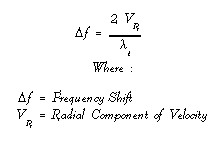
Using linear wave theory the velocity of the surface waves can be calculated. the solution to the above equation will give the size of the doppler shift for an approaching and receding wave. Note that the magnitudes will be the same with the exception of the sign. An example of a return signal is shown in the figure below. Notice how the size of the two peaks are amplified by the Bragg Scattering. The relative size of the peaks tells us which way most of the waves are moving. In the figure the negatively shifted peak is larger and therefore it can be said that the wind is forcing most of the waves offshore (i.e. an offshore breeze is present).
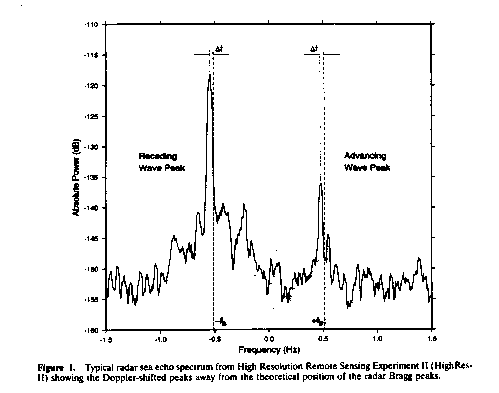
II. Range to Target
Most conventional radar systems measure the distance to a target by measuring the time delay of the return signal. If the speed of the signal and the time is known, then the total distance traveled can be calculated. The range to the target would then be half the total distance. The problem with this method is that CODAR system needs to be resolved to very fine grid points (about 1 km). Since it does not take very long for a signal travelling at the speed of light to move 1 km, a very sensitive watch is needed. CODAR overcomes this problem by sending out a frequency modulated (fm) signal. The frequency of an fm signal increases linearly with time (as shown below).
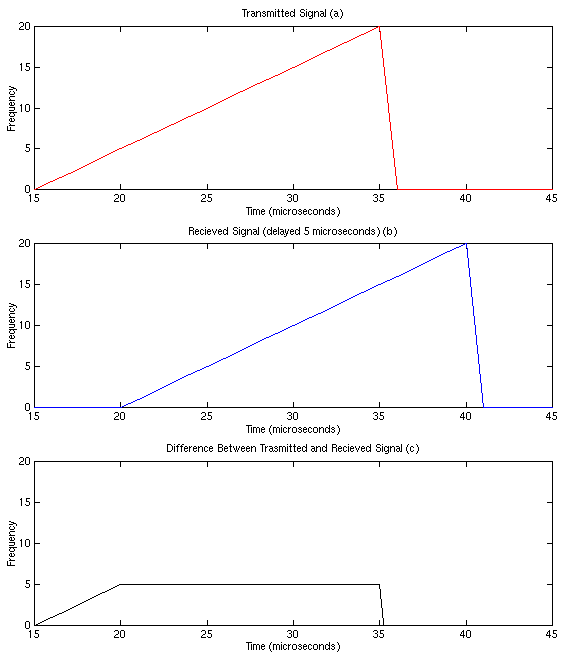
The time delay can therfore be measured by subtracting the return signal (b) from the transmitted signal (a). The difference (c) will be equal when both signals are present since they both increases at the same rate. So the higher the higher the frequency of the horizontal line, the further away the target. This time delay is then used to determine the range to the target.
III. Angular Direction of Target
The direction of the target is determined using the signal recieved by three different antennas. The three antennas include two loop antennas and a monopole. Each antenna has a different beam pattern. The monopole recieves the same signal independent of the incoming direction, omnidirectional. Signal information recieved by the monopole can therefore be used to normailize the information collected by the two loop antennas. The signal received by the two loop antennas is dependent upon the incoming direction. They are oriented ninety degrees to each other so that they can be used in combination to determine the incoming direction of the signal. When information from the two loop antennas are normalized with the monopole signal, the arctangent function is used to determine the direction of the signal. This process is referred to as Direction Finding and allows a CODAR system to have a directional resolution of one degree.
